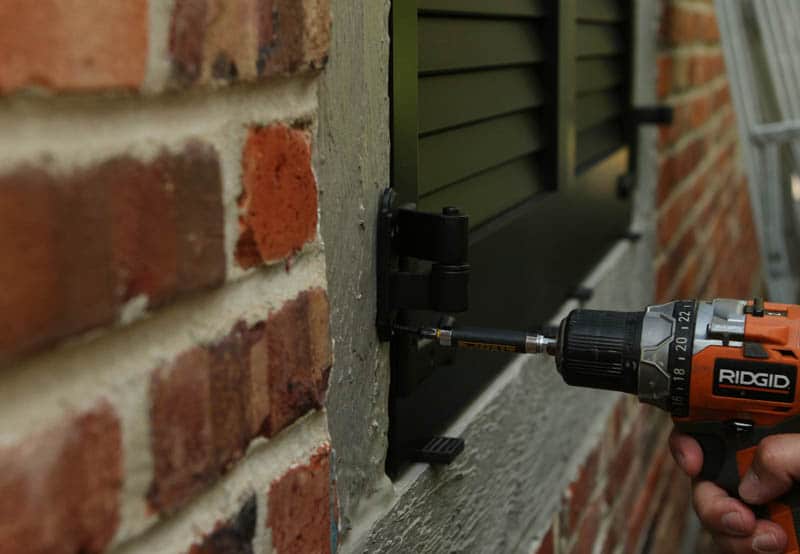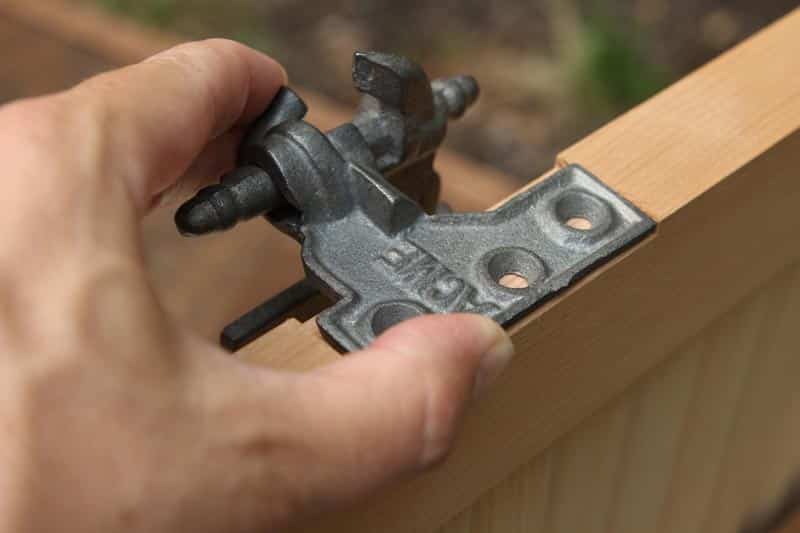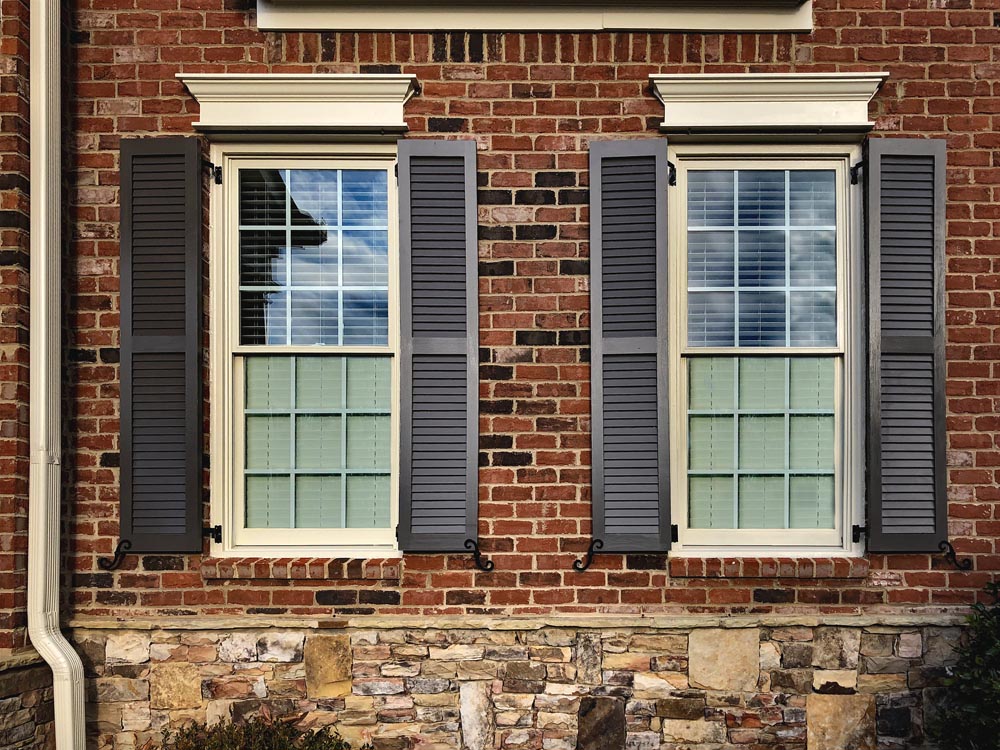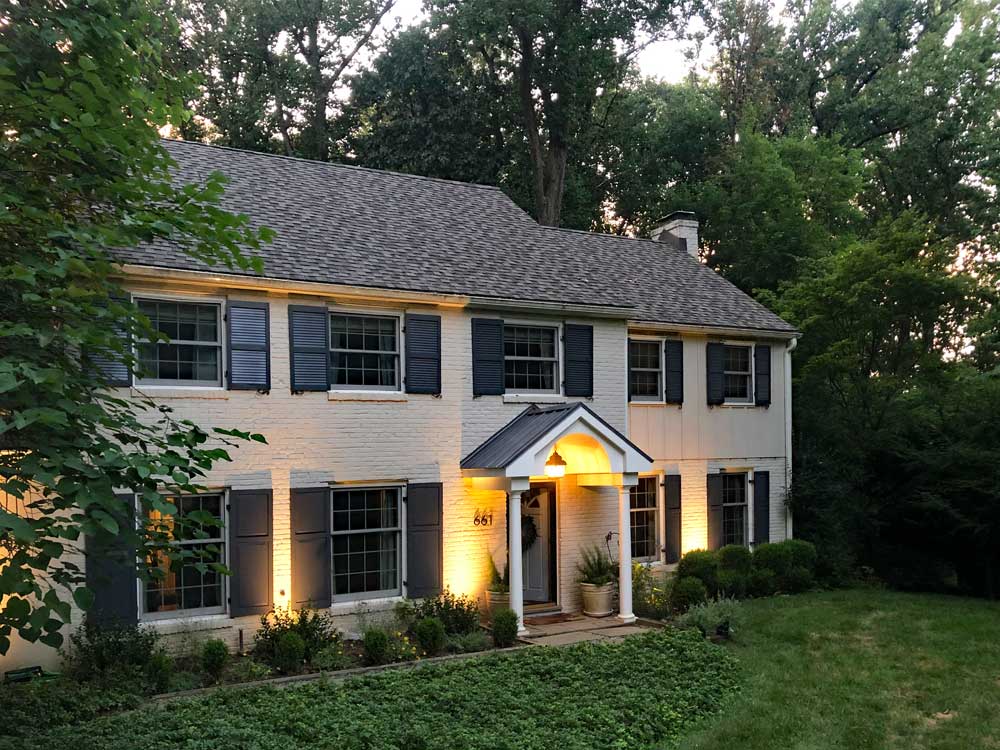How to Install Wood Exterior Shutters
The procedure to install wood exterior shutters is largely determined by the window configuration and function they will be asked to perform. The execution depends on the objective outlined in the measuring for outside shutters phase. The installed outdoor shutters will either be hinged to swing open and closed or permanently fixed in place with screws. There are several exterior shutter mounting options.

Follow the steps outlined below for a successful installation of exterior shutters. Use the videos in conjunction to the written instruction. This guide is applicable to wood louvered, solid panel, combination or board and batten shutters.
Install Exterior Shutters to Operate
Step 1: Briefly hold the shutters in the window opening with shims to establish equal spacing top and bottom with adequate margins both sides and middle. The bottom rail of the panels is equal to or larger than the top and the louvers will slant down and away from the window. Approximately 1/8 to 1/4 inch is necessary to install exterior shutters to swing freely. Outside shutters may be trimmed slightly (less than 1/4”) to increase clearance. Prime and paint the cut edge to continue.
Step 2: Observe and remove any obstructions that may prevent the panels from swinging fully open.
Step 3: With the shutters still in the window, identify where the outdoor hinges will attach. Use pieces of painter’s tape to mark each hinge location on the shutter, which can be extremely valuable when installing multiple window shutters at one time.
Attach Shutter Hinges
Step 4: Remove the panels and place horizontally on sawhorses or another flat elevated surface. The side of the outdoor shutter that was facing out will now be facing up. Replace the painter’s tape in one corner with the selected hinge. Align the strap or New York Style L-hinges vertically to the edge of the panel and horizontally to the center of the rail. Mortise hinges and narrower surface mount hinges often align more centrally.

Tip: Salvage original fittings when installing replacement shutters to save money. Recondition by using a wire brush to remove loose debris and mild corrosion. Clean and spray paint to restore the original luster.
Step 5: Use an awl to mark each hole, then tighten all screws. Mount all remaining hinges in the same fashion.
Step 6: Return the exterior shutters to the window with the shims in place. Seat each pintle into place and embed a screw into the casing through the lower hole on all four corners. Swing the panels partially open and carefully lift off of the pintles making sure not to alter their alignment. Then, fasten the remaining pintle screws.

Install Shutter Dogs
Step 7: Place the panels to the window for the last time, extended wide to the side of the opening. Identify the best shutter dog mounting point. Shutter dogs keep the panels anchored against the house and rotate to release the panels to swing freely. The lag bolt entry point should be about 1/4 the width of the shutter from the outside edge and roughly 1-1/2 inches from the bottom.
Step 8: Predrill a hole to accommodate the dog bolt. Ratchet the bolt so the back of the shutter dog meets the panel face in when fully open.
Step 9: Secure the remaining external hardware to complete the installation.
Install Exterior Shutters to be Stationary
Step 1: Temporarily hold one outside shutter in place beside the window to confirm there are no obstacles that need to be removed prior to installation. Establish also that screws placed in the four corners of the exterior panel will connect with a solid surface. The bottom rail is larger than the top and the louvers will angle up and away from the building.
Step 2: Place the wood shutter horizontally on sawhorses to drill four 1/8 inch holes in the four corners. Center the holes on the side stiles, aligned with the top of the bottom rail and bottom of the top rail. Countersink the holes on the face of the shutter if the holes will be filled before painting.
Step 3: Return the shutter to the side of the window. Insert an exterior grade screw, or bolt, in the top hole on the window side. The selected fastener should be corrosion resistant to ensure the longest possible life to permanently secure the panels in a fixed open position. Nails are not recommended because they can become loose over time, and there is a risk of damaging the face of the house shutter when pounding with a hammer. Hot dipped galvanized steel bolts are a very substantial option, but are often more bulky than necessary to install exterior shutters. The bolt head will likely sit proud of the face resulting in an unsightly appearance. High-quality exterior grade stainless steel or deck screws with a lifetime polymer coating for wood siding are recommended. Some screw heads are designed to self counter sink. Brick surfaces require specialty anchors and masonry screws. Do not tighten the screw past the panel face.

Step 4: Implant a 1/4 inch spacer between the shutter and casing. Outdoor panels installed permanently against the building may trap water, which can be damaging to the house and the window shutters. A narrow gap is sufficient to allow air to pass between the two surfaces, allowing moisture to escape and evaporate. Rubber washers or another non-corrosive spacer can be used to ensure adequate ventilation.
Step 5: Use a level on the side of the panel to ensure the final location is plumb.
Step 6: Fasten the bottom window side screw, followed by the final two corners. Excessively wide or tall shutters may benefit by the addition of screws in the vertical center of the stiles.
Step 7: Fill the void of a countersunk hole with an exterior putty, let dry, sand, then paint.
Step 8: Repeat the process for the opposite side shutter to successfully complete the installation.
Installation Tools Necessary
Most installations require:
- Sturdy ladder
- Cordless drill
- 1/8 inch drill bit
- Ratchet wrench set
- Stainless steel screws and corresponding driver bit
- 1/4 inch spacers
- Level
- Wood filler
- Putty knife
- Touch-up paint
Additional provisions may be necessary. Every window on every house is unique, which results in a unique approach and application for each situation.
Wood tropical Bahama shutters are installed with a top mounted hinge. Separate instructions are provided to install Bahama shutters.

